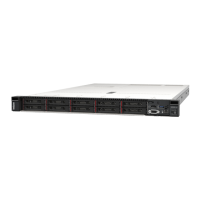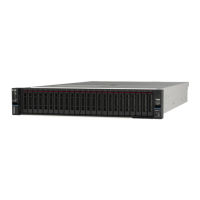Procedure
Step 1. Touch the static-protective package that contains the new part to any unpainted surface on the
outside of the server. Then, take the new part out of the package and place it on a static-protective
surface.
Step 2. Install the Firmware and RoT Security Module to the server.
Figure 192. Firmware and RoT Security Module installation
a. Lower the Firmware and RoT Security Module onto the system I/O board and ensure that
the connector on the module is correctly inserted into the slot on the system I/O board.
b.
Tighten the two screws to secure the Firmware and RoT Security Module in place.
After you finish
1. Install any components that you have removed:
•
“Install a riser card” on page 211
• “Install the rear 7mm drive assembly” on page 203
• “Install the rear hot-swap drive assembly” on page 199
2. Complete the parts replacement. See “Complete the parts replacement” on page 246.
3. Perform OneCLI commands to restore the UEFI settings. See
https://sysmgt.lenovofiles.com/help/topic/
toolsctr_cli_lenovo/onecli_r_save_command.html
.
4. Perform both OneCLI commands and XCC actions to restore the XCC settings. See
https://
sysmgt.lenovofiles.com/help/topic/toolsctr_cli_lenovo/onecli_r_save_command.html
and https://
sysmgt.lenovofiles.com/help/topic/com.lenovo.systems.management.xcc2.doc/NN1ia_c_
backupthexcc.html
.
5. Update the UEFI firmware to the specific version supported by the server. See
Tip for replacing a
Firmware and RoT Security Module
.
6. If there is a software (SW) key, for example, XCC FoD key, installed in the system, inject the key again to
ensure that the key functions properly. See
Using Lenovo Features on Demand.
Note: If you need to replace the processor board together with the Firmware and RoT Security Module,
update the VPD before injecting the key. See
“Update the Vital Product Data (VPD)” on page 238.
7. Optionally, do the following if needed:
226
ThinkSystem SR630 V3 User Guide

